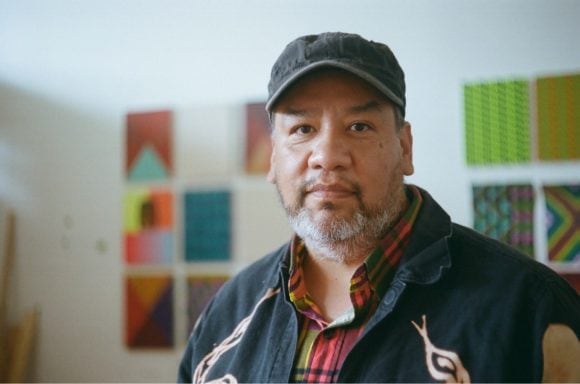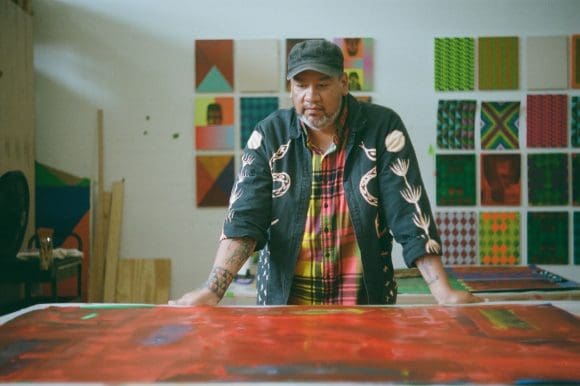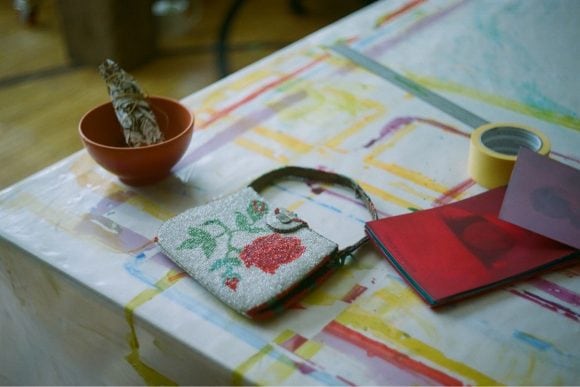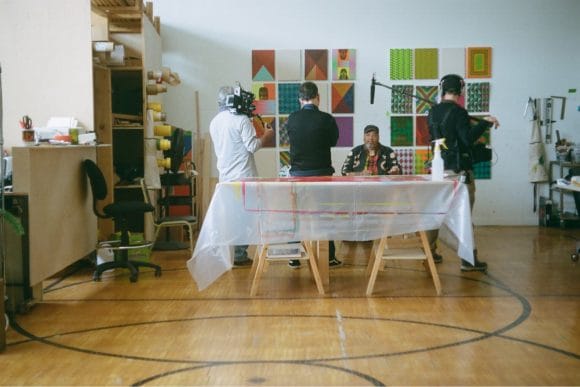
“I drew naturally as a child, and my parents encouraged that,” says Jeffrey Gibson – whose works ‘YOU SET MY SOUL ON FIRE’ (2019) and ‘DON’T YOU WANT ME LIKE I WANT YOU’ (2020) have recently been acquired by the UBS Art Collection. After a brief foray into anthropology, Gibson attended the Art Institute of Chicago, graduating with a BFA, before pursuing an MFA at the Royal College of Art in London. Today, he works alongside a team of thirteen in his studio in Hudson, New York. Mary Rozell, Global Head UBS Art Collection, joined him there to discuss his unique practice, which is closely linked to his Native American heritage.
Born in Colorado, Gibson is of Cherokee and Choctaw descent. He grew up between the US, Germany, Korea and England. As Rozell notes, he “truly is a world citizen”. He acknowledges that this exposure to a range of cultures has had a major impact on his outlook and artistic practice: “Now that I have children, thinking about exposing them to other cultures is really important, because I can see how much it’s influenced me – for the better. It’s so important to be taken out of your comfort zone.” He thinks about the experience of being a foreigner or an outside observer when making art – comparing it to the process of exploring or figuring out his subject.
Gibson’s kaleidoscopic worldview has influenced the composition of his works. In 2007, he realized the purely abstract paintings he was making featured marks that resembled weaving and beads. He began to incorporate native materials into his work – establishing a distinct, visual vocabulary whose diverse references include modernism and indigenous regalia. The approach led to celebrated works such as his repurposed Everlast punching bags, which he transforms through intricate beading, inspired by Iroquois ‘whimsies’. The first, made in 2012, stemmed from a period of intense personal frustration with “things like racism, homophobia, classism”. For Gibson, the punching bag “marks someone deciding to make a change. It’s about power and shifting relationships”.
Text, too, has become central to Gibson’s practice. “You have such great titles,” comments Rozell “Your text is pictorial in its own right yet semi-abstract”. For Gibson, the open-endedness of text is important – allowing viewers to shape their own meaning, which might shift according to “a memory, a political situation, a news event”. The artist says he collects text”– from songs he hears on the radio, to books, poems and the “house, soul, swing and jungle” music he grew up with. Other sources are more personal: “The first punching bag I made using text just has the word ‘believe’ on it. That was literally me speaking to myself, like ‘Jeff, Believe! Believe!’”.
Stay tuned in on art
Stay tuned in on art
Subscribe to our newsletter and receive the latest insights.




